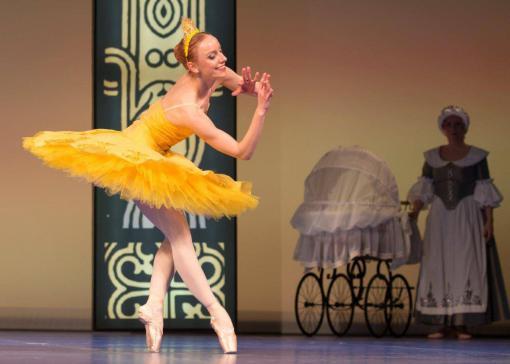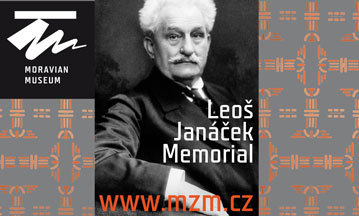The classical ballet Sleeping Beauty in four parts (prologue and three acts) by Pyotr Ilyich Tchaikovsky was performed by the National Theatre Brno on the stage of the Mahen Theatre.
We all know the classical fairytale about Sleeping Beauty. What are the parallels with the Russian Sleeping Beauty, for which the libretto was written by Ivan Vsevolozhsky, but essentially and remarkably re-written by Marius Petipa, who directed the whole work? Fates turn into fairies, because in white ballet – ballet blanc – everything must be airy, floating above the earth's surface. Princess Briar Rose is called Aurora and the Prince is named Desiré. Eventually, at the end of the story, other famous fairy-tale characters enter, such as the Wolf and Little Red Riding Hood, Puss in Boots, and the lesser known White Cat and Blue Bird with Princess Florina. Precious stones are also added, headed by Diamond. Why though? They come to congratulate Aurora and Desiré for their love, and rejoice that the curse has been removed. The choreographer Marius Petipa was given additional dance figures to enrich the whole dance component of the ballet, the so-called divertissement. He fully developed his intention in Tchaikovsky’s third ballet – The Nutcracker, where almost the entire second half of the story is full of divertissements. It also showed the richness of Petipa's choreographic and movemental diversity.
An interesting feature of the ballet Sleeping Beauty is that ever since its inception, it has been associated with rich stage design and splendid costumes. This path was taken by the National Theatre Brno as well, although in its own particular manner. The stage design (by Peter Čanecký) is seemingly simple in the spirit of art deco, where large images of roses in a sober violet – blue – green shades, with a touch of pink here and there, make the stage look more united and sightly. They seize a reasonable amount of attention so that viewers can immerse themselves in the dance’s splendour. If the audience missed the eye, the complexity of shapes on the portals and in the second half (2nd and 3rd acts) and on the whole prospect (the back wall of the stage) tangles them up in its pleasant maze. Costumes (by Ľudmila Várossová) highlight and underline the nature of the characters. The choir, as well as the main protagonists, are not short of colourful ballerinas, accompanied by a colour-tuned top part in the shape of a corset – in short, a classic costume. The walk-ons – young conservatoire female students – and the Queen may have long skirts, but those are fluffy, also in the style of classic ballet’s elegance, and they are nothing short of the variety and creativity of those mentioned earlier. As the story takes place in the royal court and in addition also in a fairy tale, the shades, the materials and the decorations are truly varied even on the male actors. Maybe just for Aurora, in the first part, it might have been better to choose a different shade of pink, because the colour of the skin of Klaudia Radačovská does not suit it very well and looks faded. According to the photos of the other alternating cast in the programme brochure, Eriko Wakizono shines bright though, because her skin tone is a bit darker. As in the story we see the opposing figures of the wicked fairy Carabosse and the good fairy Lilac, and there symbolism appears to us in the choosing of the colours for their costumes. Carabosse is shrouded in dark purple, and the Lilac fairy in bright, fine lilac.
It is said that if you manage to dance the role of Sleeping Beauty, in its full technical complexity, then you can do anything. But if you think that the remaining characters are somehow remarkably lighter, you're very wrong. The figures of Lilac, Prince Desiré, the fairies, Puss in Boots and the White Cat, the Blue Bird, and Princess Florina. All these numbers and characters are packed with a peculiar character, which is illustrated with narrative talent also in technical-movemental difficulty, and even in the choreographic shaping. In addition, everything fits into a compact unit. The exact movement of all the dancers, soloists, choirmasters and conservatoire students marvellously fits together in perfect harmony. The precision with which the choreography was studied by the director Bakhram Maripovich Yuldashev according to Marius Petipa and the ballet master Jana Ruggieri, works as a singular entity.
In most cases Carabosse is danced by a man. This tradition stems from the first production of this ballet. It is true that from time to time a theatre appears that engages a female dancer in the role of the wicked fairy, but in Brno they stick to the original. Thoriso Magongwa was very striking as a performer, although he did not get much space as a dancer in this role. Working with the mallet and the differences in its meaning (once as a symbol of power, strength, determination, sometimes as a point of support in times of weakness) were clearly readable even for those who are not used to ballet’s speech without words. As I recalled above, this ballet is full of dance and mainly technical challenges. The performer of Aurora must have tremendous stamina, especially in the 1st act during the Rose Adagio and in the 2nd act, when the Prince meets Aurora for the first time, that is to say – with a vision of her, represented to him by the Lilac fairy. In the first case, she has to make a very clear and visible entry to the scene and into the story. She must step in with the typical energy of a sixteen-year-old, but at the same time show the neat finesse of expression, because she is in fact a royal daughter. Her whole character should be accompanied by lightness, despite the technical difficulty of movement. Long held balance, playful suivi, picked chainé and rond de jambe en l'air up to heaven. These are her synonyms. During the dance of a prima ballerina, we should feel that she is enjoying it. Klaudia Radačovská, who appeared as Aurora at the premiére, appeared to be trying to show the features technically correctly and there was little energy left for expression. This may have made her a little bit uneasy, and finally her technique was uncertain in some moments. Her suivi and chainé were burdened. In the partnerine, it was as if she were afraid to move.
In ballet blanc the ballerina has plenty of space and it is said that her partner is only a "lifter" to her. In this couple, however, the leader was the first soloist of the Prague ballet Karel Audy as a guest, who surpassed his female partner with his expression and performance. In his dance expression, a change of mood was seen when the Prince appeared among his courtiers in public, and when he is left alone and a desire is revealed in him for something greater. He's lost and seeking. In the second act, which is technically challenging, you should see what he expresses rather than the individual steps. And that worked wonders for him. His grand jeté is all-embracing and his lufturas fast and light as a feather.
The whole story is accompanied by the Lilac Fairy, and in the case of Andrea Popov Smejkalova it is a sight for sore eyes. Her expression, technique, accuracy, heart, lightness, grace, scope, everything is fascinating. When she is on the stage, she will not let you take your eyes from her. The fairies complement her nicely, especially the Fairy of Mindlessness as danced by Barbora Bielková. She is playful and skilfully fulfils her name. The Fairy of Eternity and Emerald, performed by Michaela Krajčová, was catching up a little behind her colleagues. Perhaps it was just her nervousness. I'll see what this will be like in upcoming performances; I'm going to look at other alternations, too. The remaining gemstones were fresh and nicely complemented the figures of the fairy-tale characters. Little Red Riding Hood (Carolina Cogollos Isach) and the Wolf (Václav Šutorka) briefly exposed their story, which they performed in a humorous and laid-back fashion. Puss in Boots (Arthur Abram) and the White Cat (Barbora Bielková) exactly comprehended the cat’s movements, so funny and lazy. The Blue Bird (Burak Serkan Cebeci) actually flew on the stage. His ability to keep up in the air was unbelievable. Together with Princess Florina (Ichigo Oguro) they made a perfect pair. They had grace and synchronicity. The Princess was playful with beautiful airy arabesques. Her face and body seemed to be completely devoted to dance.
Just as the music draws you into the plot at the beginning, it kept you inside the story all the time, along with all the dancers. You travelled in the story, as when a little child visualises a bedtime story. The impression was magnified by the Mahen Theatre, which contributed to this successful Sleeping Beauty with its historical charm.
































No comment added yet..